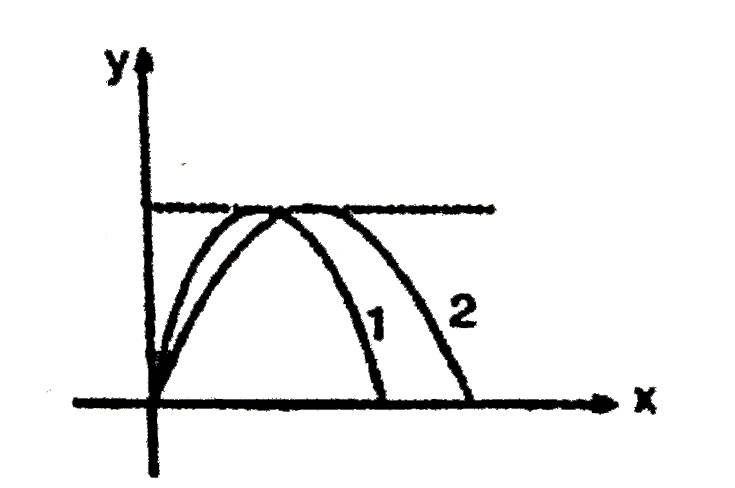Two projectiles are thrown same speed in such a way that their ranges are equal. If the time of flights for the two projectiles are t1 and t2 the value of 't1t2' in terms of range 'R' and 'g' is
R/4g
R/g
R/2g
2R/g
The correct Answer is:C
To solve the problem, we need to find the product of the time of flights t1 and t2 for two projectiles thrown with the same speed such that their ranges are equal. Let's go through the solution step by step.
Step 1: Understanding the Time of Flight Formula
The time of flight T for a projectile is given by the formula:
T=2usinθg
where:
- u is the initial speed,
- θ is the angle of projection,
- g is the acceleration due to gravity.
Step 2: Time of Flight for Each Projectile
For the first projectile with angle θ1:
t1=2usinθ1g
For the second projectile with angle θ2:
t2=2usinθ2g
Step 3: Product of Time of Flights
Now, we can find the product of t1 and t2:
t1t2=(2usinθ1g)(2usinθ2g)=4u2sinθ1sinθ2g2
Step 4: Relationship Between Angles
Since the ranges of the two projectiles are equal, we can use the property of complementary angles in projectile motion. If θ1+θ2=90∘, then:
sinθ2=cosθ1
Step 5: Substitute into the Product Equation
Substituting sinθ2 into the product equation:
t1t2=4u2sinθ1cosθ1g2
Step 6: Use the Double Angle Identity
We can use the double angle identity for sine:
sin2θ=2sinθcosθ
Thus,
sinθ1cosθ1=12sin2θ1
So we can rewrite the product as:
t1t2=4u2g2⋅12sin2θ1=2u2sin2θ1g2
Step 7: Relate to Range
The range R of a projectile is given by:
R=u2sin2θg
Thus, we can express sin2θ1 in terms of R:
sin2θ1=Rgu2
Step 8: Substitute Back
Substituting this back into our equation for t1t2:
t1t2=2u2g2⋅Rgu2=2Rg
Final Answer
Thus, the product of the time of flights t1t2 in terms of range R and gravitational acceleration g is:
2Rg
The time of flight T for a projectile is given by the formula:
T=2usinθg
where:
- u is the initial speed,
- θ is the angle of projection,
- g is the acceleration due to gravity.
For the first projectile with angle θ1:
t1=2usinθ1g
t2=2usinθ2g
Now, we can find the product of t1 and t2:
t1t2=(2usinθ1g)(2usinθ2g)=4u2sinθ1sinθ2g2
Since the ranges of the two projectiles are equal, we can use the property of complementary angles in projectile motion. If θ1+θ2=90∘, then:
sinθ2=cosθ1
Substituting sinθ2 into the product equation:
t1t2=4u2sinθ1cosθ1g2
We can use the double angle identity for sine:
sin2θ=2sinθcosθ
Thus,
sinθ1cosθ1=12sin2θ1
So we can rewrite the product as:
t1t2=4u2g2⋅12sin2θ1=2u2sin2θ1g2
The range R of a projectile is given by:
R=u2sin2θg
Thus, we can express sin2θ1 in terms of R:
sin2θ1=Rgu2
Substituting this back into our equation for t1t2:
t1t2=2u2g2⋅Rgu2=2Rg
Thus, the product of the time of flights t1t2 in terms of range R and gravitational acceleration g is:
2Rg
Topper's Solved these Questions
Similar Questions
Knowledge Check
The relation between the time of flight of projectile Tf and the time to reach the maximum height tm is
ATf=2tmBTf=tmCTf=tm2DTf=√2(tm)
A projectile has a time of flight T and range R. If the time of flight is doubled, keeping the angle of projection same, what happens to the range ?
View SolutionA projectile has same range for two angules of projection. If times of flight in two cases are t1andt2 then the range of the projectilie is
View SolutionAn object projected with same speed at two different angles covers the same horizontal range R. If the two times of flight be t1andt2 . The range is 1αgt1t2, the value of α is
View SolutionThere are two values of time for which a projectile is at the same height. The sum of these two times is equal to (T = time of flight of the projectile)
View SolutionFor a given velocity, a projectile has the same range R for two angles of projection. If t1 and t2 are the time of flight in the two cases, then t1⋅t2 is equal to
View SolutionA projectile has the same range R for angles of projections. If T1andT2 be the times of fight in the two cases, then ( using θ as the angle of projection corresponding to T1 )
View SolutionTwo stones are projected from level ground. Trajectory of two stones are shown in figure. Both stones have same maximum heights above level ground as shown. Let T1 and T2 be their time of flights and u1 and u2 be their speeds of projection respectively (neglect air resistance). then

View Solution
